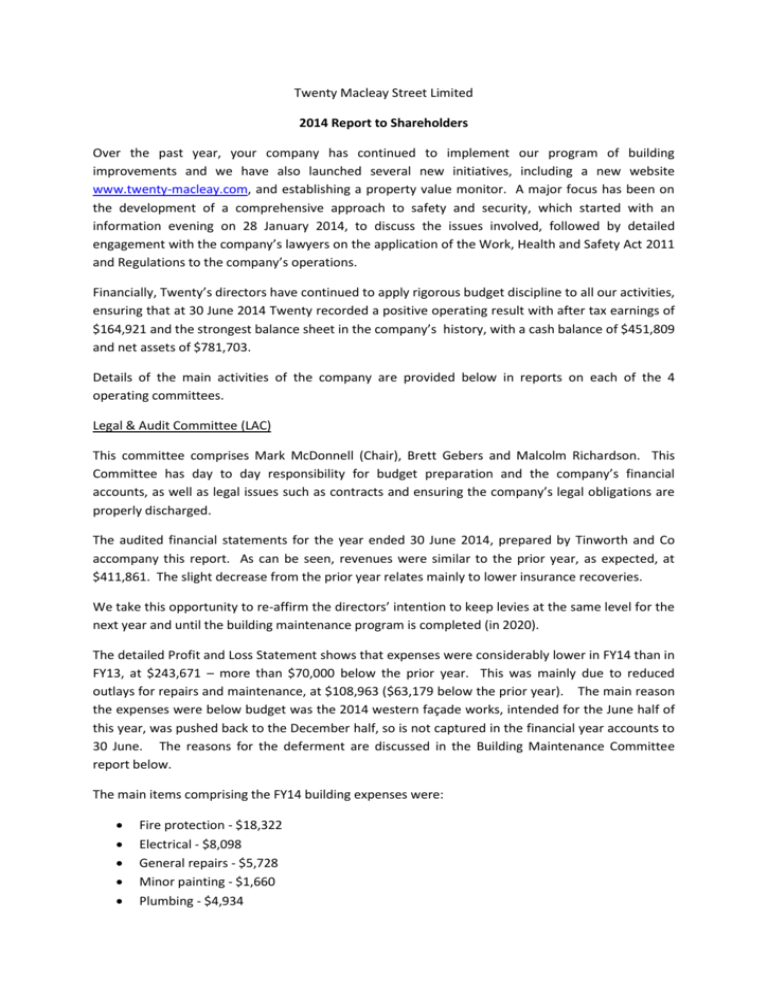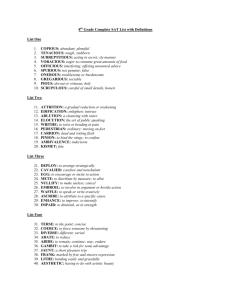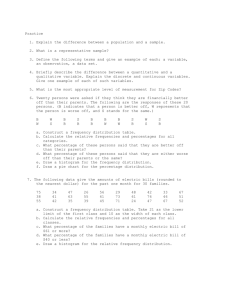2014 Report to shareholders - twenty macleay street limited
advertisement

Twenty Macleay Street Limited 2014 Report to Shareholders Over the past year, your company has continued to implement our program of building improvements and we have also launched several new initiatives, including a new website www.twenty-macleay.com, and establishing a property value monitor. A major focus has been on the development of a comprehensive approach to safety and security, which started with an information evening on 28 January 2014, to discuss the issues involved, followed by detailed engagement with the company’s lawyers on the application of the Work, Health and Safety Act 2011 and Regulations to the company’s operations. Financially, Twenty’s directors have continued to apply rigorous budget discipline to all our activities, ensuring that at 30 June 2014 Twenty recorded a positive operating result with after tax earnings of $164,921 and the strongest balance sheet in the company’s history, with a cash balance of $451,809 and net assets of $781,703. Details of the main activities of the company are provided below in reports on each of the 4 operating committees. Legal & Audit Committee (LAC) This committee comprises Mark McDonnell (Chair), Brett Gebers and Malcolm Richardson. This Committee has day to day responsibility for budget preparation and the company’s financial accounts, as well as legal issues such as contracts and ensuring the company’s legal obligations are properly discharged. The audited financial statements for the year ended 30 June 2014, prepared by Tinworth and Co accompany this report. As can be seen, revenues were similar to the prior year, as expected, at $411,861. The slight decrease from the prior year relates mainly to lower insurance recoveries. We take this opportunity to re-affirm the directors’ intention to keep levies at the same level for the next year and until the building maintenance program is completed (in 2020). The detailed Profit and Loss Statement shows that expenses were considerably lower in FY14 than in FY13, at $243,671 – more than $70,000 below the prior year. This was mainly due to reduced outlays for repairs and maintenance, at $108,963 ($63,179 below the prior year). The main reason the expenses were below budget was the 2014 western façade works, intended for the June half of this year, was pushed back to the December half, so is not captured in the financial year accounts to 30 June. The reasons for the deferment are discussed in the Building Maintenance Committee report below. The main items comprising the FY14 building expenses were: Fire protection - $18,322 Electrical - $8,098 General repairs - $5,728 Minor painting - $1,660 Plumbing - $4,934 Balance of ground floor refurbishment costs - $46,295 Bike rack - $5,986 Lift - $7,880 Various small jobs (intercom, door strike, TV and window repairs) - $5,957 Sundry other expenses - $4,103 The detailed Profit and Loss account also shows lower costs than in the prior year for cleaning, management fees, electricity and water charges and a range of other, smaller items. These savings were partly offset by some cost increases, mainly relating to insurance, legal, postage and printing costs, but overall operating expenses were reduced. The purpose in accumulating a large cash surplus is to fund ongoing building improvements. In last year’s report we noted that the western façade works were budgeted for FY14 but this project is now expected to be undertaken in the second half of calendar 2014. Last year’s report estimated a closing cash balance of $92,000 assuming the western façade works and associated architect fees were paid. Since these costs were not incurred, the actual year end cash balance, of about $452,000 should be adjusted by $348,000 in deferred costs, for an adjusted “look through” cash outcome of $104,000. In other words, on a cash basis, the actual results were $12,000 ahead of projections published in last year’s Report to Shareholders, excluding the large project deferral. Looking to the year ahead, the budget to 30 June 2015 is as follows: Opening cash Levies Other income Total cash resources Western façade works Consultancies Other building maintenance Fire protection/ monitor Legal and accounting Utilities Management fees Cleaning Insurance Other admin costs Total outlays Estimated closing cash 451809 400000 12000 863809 470747 18000 100000 19000 9000 60000 16000 21000 30000 6000 749747 114062 For the current financial year the directors have increased the budget for western façade works from $330,000 to $470,747, with $18,000 for associated consultancy costs (architect fees). The new estimate reflects a revised and expanded scope of works, including replacing all windows at the front of the building. In addition, there are a range of other expenses expected to be incurred in the year ahead, mainly in relation to ongoing improvements to the electrical services in the building (Phase 2) and a number of security related costs (CCTV, spare key safe, occupant warning system, new smoke alarms and, possibly, new keyless access for entry doors). In total, the substantial expected FY15 outlays on these projects have been made possible by the 30 June cash balance of approximately $450,000. Note that the estimated closing cash balance of $114,062 reflects the expected position at 30 June 2015. With additional levies due in the December half of 2015, the FY15 budget and closing cash position is consistent with a cash balance forecast for the start of 2016 calendar year as set out in the 10 year capital works program of $202,000 (refer to last year’s Report to Shareholders for details). Finally, the LAC dealt with a number of legal issues during the year including: Resolution of a long running dispute with Schindler Lifts Australia Pty Ltd over warranty items relating to problems with the original installation of the lift; Resolution of a dispute with FOXTEL regarding poor installation practices at Twenty causing service disruption to residents; A new contract with Advanced Fire and Electrical relating to continuing improvements to electrical services at Twenty as well as an emergency call out service; Finalisation of standard additional clauses for inclusion in rental leases for tenants residing at Twenty; A new contract with Machineiq for web site maintenance and hosting; Development of an Emergency Policy and Procedure in close consultation with the company’s solicitors, Makinson d’Apice to ensure compliance with the Work, Health and Safety Act 2011. A copy of the new policy is attached to this report and will be discussed at the forthcoming 2014 Annual General Meeting; Devising a range of recommended changes to the company’s Constitution, also attached to this report, and to be put as special resolutions at the 2014 AGM. These resolutions are designed to improve the emergency management of the property including apartment access. Building Maintenance Committee (BMC) This Committee comprises Keith Cottier (Chair), Richard Hambly, Hugh Murray Walker and Mark McDonnell. It deals with both routine maintenance and repair issues and carries out most of the detailed planning and oversight of the company’s capital works program. An example of the more routine repairs carried out relates to fixing problems with TV reception. Another is water leaks and seepage into various apartments, which the Committee seeks to identify and remedy as quickly as possible. Oddly, these leaks are not always promptly reported by the residents most affected. This year leaks into several apartments were found and fixed. The leaks often relate to shower areas and problems with waterproofing, but there are also cases where pipes and seals need replacing. Wherever possible the BMC tries to respond to shareholder concerns and requests. A couple of examples this year were the staining of the timber panels in the lift car, and the purchase of a seat opposite the lift on the ground floor. Directors are delighted that these initiatives have met with widespread approval. One of the more visible examples of BMC activities in the last year was the construction of a bike rack in the northern courtyard area, undertaken by Pro Build. There is now under cover storage for 10 bicycles and we are pleased to see the facility is being used by residents, with some spare capacity remaining. As mentioned in the LAC report, safety issues at Twenty have been a priority area this year and a number of new facilities, such as CCTV and keyless access have been identified for improvements in the year ahead. Since our last report, a hatch and safety harness system has been installed on the roof so work carried out from there can be undertaken without the risk of workers falling. Another important safety related activity this year was arranging for complete replacement of all smoke alarms in each apartment, as the original alarms had reached their “use by” date. Improved electrical services have remained a focus area. During the year, to reduce the load on the building power supply, new gas driers were installed in the laundry. The winter of 2014 was the first in some years that Twenty has not suffered a building wide black-out, thanks to the load rebalancing measures and increased supply arrangements previously adopted. 2014 will see the completion of the RCD (Residual Current Devices) installation program in every apartment throughout the building. (Note: RCDs are safety switches designed to shut off electrical supplies when an imbalance is detected in an electrical circuit. This can occur when a power supply has been connected to a faulty appliance or when a person accidentally touches an energised piece of equipment. Circuit imbalances can results in fatalities if the RCD does not disconnect or “trip” the circuit instantly.) Completion of the RCD work has paved the way for “Phase 2” of the electrical services work to begin. Phase 2 involves new wiring from the central riser into each apartment, with a new circuit board to be located within the apartment, rather than in an outside cupboard or common area. As part of Phase 2 works, new fibre optic cable will also be provided into each apartment for future broadband and other telecommunications services delivery. Like the RCD work, Phase 2 involves work in every apartment in the building and is a multi-year project. The findings from the RCD work about the condition and performance of electrical wiring in each apartment will be used in setting priorities for the sequence of Phase 2 upgrades, with those apartments showing the worst circuit performance upgraded first. The largest and most expensive project to be undertaken in 2014 will be the western façade refurbishment. Although the refurbishment work has not yet started, a considerable amount of preparatory work was undertaken. The BMC arranged for detailed investigations around the construction of the zig zag windows to be carried out, as original plans for the building have long been lost, and the renovation work could only be properly defined once the nature of this unusual design feature at the front of the building was more fully understood. The investigative work required removal of windows and dismantling some of the surrounding structures, but as a result of the investigation, the company’s architect, Ian Burl, was able to prepare detailed drawings. Subsequently Mr Burl completed the request for tender specification for this work and, at the time of writing this report, the company is expecting to receive several competing proposals from builders to undertake the work over coming months. Finally, Keith Cottier has been in negotiations with Sydney City Council around a variation to the Development Application so as to allow lower maintenance aluminium framed windows (white powder coat finish) to be installed to replace existing windows at the front of the building. By the time of the AGM, we expect to be in a position to provide shareholders with a further update on the progress of the western façade works. Every effort will be made to minimise disruption and inconvenience once the work begins. House Management Committee (HMC) The HMC comprises Judith Barbour (Chair), David Whitfield, Malcolm Richardson and Mark McDonnell. During the year the main activity of the HMC was to arrange for directors to interview and approve prospective tenants and shareholders at Twenty. There was an increased turnover in shareownership over the past year and we take this opportunity to welcome as new shareholders Messrs Randall Pearce & Manfred Unterfenger (U38), Mr Peter and Mrs Catherine Smyth (U2 & U20), Ms Kathryn Penfold (U1), Ms Charlotte Westmacott (U19), Mr Trent Spears & Ms Ingrid Cameron (U34). Every year there is also a steady turnover of tenants at Twenty and 2014 has been no exception, with changes in residency in 10 apartments over the past year, with the new occupants being interviewed and approved by directors in each case. This rate of turnover represents almost onethird of all the apartments being rented, and reflects a pattern of short term tenancies at Twenty, as well as some occasions where longer term residents decide to move on. The HMC also considers comments, requests and complaints from shareholders which arise from time to time. Overall, most issues relating to building defects or problems are reported directly to Sydney Company Title Management, as the building manager, but in addition there are some complaints to the HMC about services provided to the company (eg. garbage collection, cleaning etc), noise, and occasionally, around safety and security issues. The managing agents and Board work together to resolve all bona fide problems as quickly as possible. Another key role of the HMC is to review the operation of the House Rules and related policies and recommend updates or revisions where needed. This is an ongoing activity. Shareholders are reminded the best way to contact the company is via the Managing agents, Sydney Company Title Management, at 680 Willoughby Rd, Willoughby. Kinen Lau from SCTM is our company secretary and can be reached by telephone on 8973 1000 or email kinen.lau@picaust.com.au. Alternately, written correspondence can be deposited at the U27 letterbox at the entrance to the building. For urgent matters, a list of other contacts is displayed in the noticeboard on the lower ground floor. Strategic Planning Group (SPG) The two projects undertaken by the SPG (Brett Gebers – chair, Hugh Murray Walker, Randall Pearce, Mark McDonnell) were the launch of a website (www.twenty-macleay.com) and development of a property value monitor. The website is intended to serve both as a vehicle for promoting the company’s main asset (our building) as well as a practical management tool, for providing information about the management and operations of the company. Copies of key documents are to be found there, both current and for several years past, as well as providing some longer term historical notes on the site and building and other points of interest. We expect the website will continue to be upgraded over the coming year with new photos and text added. As mentioned in last year’s report, the Board resolved last year “that the company begins tracking unit sale prices at Twenty and the surrounding area. Given the significant investment in our program of works, we should expect to see property values increase in our building at a rate that exceeds average growth in comparable Potts Point buildings. We propose to assess this at the mid-point of our program, July 2015, to ensure that investment decisions are delivering an increase in shareholder value.” Further to this resolution, the table below sets out a summary of the transaction history for apartment sales at Twenty over the past 5 years, with the implied value of the building based on an averaging of transaction values over defined time periods. In this way, the general increase in the value of Twenty shareholdings can be measured. Number of sales Years Average implied value for Twenty Change (%) 5 2014 33,911,311 7.7% 5 2011-2013 31,500,470 23.9% 5 2009-2010 25,424,062 base The base value of $25.4M in 2009-10 is based on 5 apartment sales in that period, which coincides with the start of Twenty’s 10 year capital works program. The “implied value” refers to the value of the company as a whole and is calculated for each sale based on the percentage shareholding represented by each apartment, when the associated shares were sold. As can be seen, there were relatively few sales in the next 3 years but a further 5 sales from 2011 to 2013 occurred, where the average improvement in the company’s value was $6M, or almost 24% above the base value, to $31.5M. This strong increase in value provides clear evidence of the value of the company’s re-investment strategy, where shareholders are enjoying a significantly higher return than the moneys outlaid to fund capital works improvements. So far in 2014, there have been another 5 sales, with a 7.7% further increase in value to $33.9M. In other words, since the start of the 5 year capital works program, there has been a 33% increase in average property values at Twenty. The effectiveness of the reinvestment strategy is also very clearly shown by reference to one apartment, which was sold twice in the period under review. It was attractively renovated in 2013 with the result that on re-sale it gained 51% in value from its 2012 sale price. It provides an indication of the potential capital appreciation shareholders can achieve where good quality renovation work is undertaken. This case also shows that the best returns are likely to be enjoyed by shareholders whose own investments in Twenty complement those of the company. Over the year ahead, the company will continue to develop the property value monitor, consistent with our objective of providing a more comprehensive report in mid-2015. At this stage, however, it seems fair to say the results appear to be highly encouraging. Mark McDonnell Chairman







